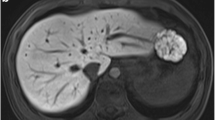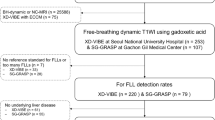Abstract
Objective
Evaluate the image quality and diagnostic performance of a free-breathing 3D-gradient-echo sequence with radial acquisition (rGRE) compared with a Cartesian breath-hold 3D-GRE (cGRE) sequence on hepatobiliary phase MRI in patients with breath-holding difficulties.
Methods
Twenty-eight consecutive patients (15 males; mean age 61 ± 11.9 years) were analysed in this retrospective IRB-approved study. Breath-holding difficulties during gadoxetate-disodium-enhanced liver MRI manifested as breathing artefacts during dynamic-phase imaging. MRI included axial and coronal cGRE and a radially sampled rGRE sequence during the hepatobiliary phase. Two radiologists independently evaluated cGRE and rGRE images for image quality, liver lesion detection and conspicuity, and bile duct conspicuity on a four-point scale.
Results
Liver edge sharpness was significantly higher on rGRE images (P < 0.001). Overall image quality was slightly but significantly higher for rGRE than for cGRE (P < 0.001 and P = 0.039). Bile duct conspicuity scores of rGRE and cGRE were not significantly different. Sensitivity for detection of the 26 liver lesions was similar for rGRE and cGRE (81-77 % and 73-77 %, P = 0.5 and 1.0). Lesion conspicuity scores were significantly higher for rGRE for one reader (P = 0.012).
Conclusion
In patients with breath-holding difficulties, overall image quality and liver lesion conspicuity on hepatobiliary phase MRI can be improved using the rGRE sequence.
Key Points
• Patients with diminished breath-holding capacities present a major challenge in abdominal MRI.
• A free-breathing sequence for hepatobiliary-phase MRI can improve image quality.
• Further advances are needed to reduce acquisition time of the free-breathing gradient-echo sequence.


Similar content being viewed by others
References
Schultz CL, Alfidi RJ, Nelson AD, Kopiwoda SY, Clampitt ME (1984) The effect of motion on two-dimensional fourier transformation magnetic resonance images. Radiology 152:117–121
McKenzie CA, Lim D, Ransil BJ et al (2004) Shortening MR image acquisition time for volumetric interpolated breath-hold examination with a recently developed parallel imaging reconstruction technique: Clinical feasibility. Radiology 230:589–594
Vogt FM, Antoch G, Hunold P et al (2005) Parallel acquisition techniques for accelerated volumetric interpolated breath-hold examination magnetic resonance imaging of the upper abdomen: Assessment of image quality and lesion conspicuity. J Magn Reson Imaging 21:376–382
Klessen C, Asbach P, Kroencke TJ et al (2005) Magnetic resonance imaging of the upper abdomen using a free-breathing T2-weighted turbo spin echo sequence with navigator triggered prospective acquisition correction. J Magn Reson Imaging 21:576–582
Lee SS, Byun JH, Hong HS et al (2007) Image quality and focal lesion detection on T2-weighted MR imaging of the liver: Comparison of two high-resolution free-breathing imaging techniques with two breath-hold imaging techniques. J Magn Reson Imaging 26:323–330
Young PM, Brau AC, Iwadate Y et al (2010) Respiratory navigated free breathing 3D spoiled gradient-recalled echo sequence for contrast-enhanced examination of the liver: Diagnostic utility and comparison with free breathing and breath-hold conventional examinations. AJR Am J Roentgenol 195:687–691
Pipe JG (1999) Motion correction with PROPELLER MRI: Application to head motion and free-breathing cardiac imaging. Magn Reson Med 42:963–969
Chandarana H, Block TK, Rosenkrantz AB et al (2011) Free-breathing radial 3D fat-suppressed T1-weighted gradient echo sequence: A viable alternative for contrast-enhanced liver imaging in patients unable to suspend respiration. Invest Radiol 46:648–653
Azevedo RM, de Campos RO, Ramalho M, Heredia V, Dale BM, Semelka RC (2011) Free-breathing 3D T1-weighted gradient-echo sequence with radial data sampling in abdominal MRI: Preliminary observations. AJR Am J Roentgenol 197:650–657
Song HK, Dougherty L (2000) k-space weighted image contrast (KWIC) for contrast manipulation in projection reconstruction MRI. Magn Reson Med 44:825–832
Cruite I, Schroeder M, Merkle EM, Sirlin CB (2010) Gadoxetate disodium-enhanced MRI of the liver: Part 2, protocol pptimization and lesion appearance in the cirrhotic liver. AJR Am J Roentgenol 195:29–41
Feuerlein S, Boll DT, Gupta RT, Ringe KI, Marin D, Merkle EM (2011) Gadoxetate disodium-enhanced hepatic MRI: Dose-dependent contrast dynamics of hepatic parenchyma and portal vein. AJR Am J Roentgenol 196:W18–24
Ringe KI, Husarik DB, Sirlin CB, Merkle EM (2010) Gadoxetate disodium-enhanced MRI of the liver: Part 1, protocol optimization and lesion appearance in the noncirrhotic liver. AJR Am J Roentgenol 195:13–28
Bashir MR, Husarik DB, Ziemlewicz TJ, Gupta RT, Boll DT, Merkle EM (2012) Liver MRI in the hepatocyte phase with gadolinium-EOB-DTPA: Does increasing the flip angle improve conspicuity and detection rate of hypointense lesions? J Magn Reson Imaging 35:611–616
Frydrychowicz A, Nagle SK, D'Souza SL, Vigen KK, Reeder SB (2011) Optimized high-resolution contrast-enhanced hepatobiliary imaging at 3 tesla: A cross-over comparison of gadobenate dimeglumine and gadoxetic acid. J Magn Reson Imaging 34:585–594
Landis JR, Koch GG (1977) The measurement of observer agreement for categorical data. Biometrics 33:159–174
Altun E, Semelka RC, Dale BM, Elias J Jr (2008) Water excitation MPRAGE: An alternative sequence for postcontrast imaging of the abdomen in noncooperative patients at 1.5 Tesla and 3.0 Tesla MRI. J Magn Reson Imaging 27:1146–1154
Kim JH, Hong SS, Eun HW, Han JK, Choi BI (2012) Clinical usefulness of free-breathing navigator-triggered 3D MRCP in non-cooperative patients: Comparison with conventional breath-hold 2D MRCP. Eur J Radiol 81:e513–518
Hirokawa Y, Isoda H, Maetani YS, Arizono S, Shimada K, Togashi K (2008) MRI artifact reduction and quality improvement in the upper abdomen with PROPELLER and prospective acquisition correction (PACE) technique. AJR Am J Roentgenol 191:1154–1158
Rosenkrantz AB, Mannelli L, Mossa D, Babb JS (2011) Breath-hold T2-weighted MRI of the liver at 3T using the BLADE technique: Impact upon image quality and lesion detection. Clin Radiol 66:426–433
Hirokawa Y, Isoda H, Maetani YS et al (2009) Hepatic lesions: Improved image quality and detection with the periodically rotated overlapping parallel lines with enhanced reconstruction technique—evaluation of SPIO-enhanced T2-weighted MR images. Radiology 251:388–397
Hirokawa Y, Isoda H, Maetani YS, Arizono S, Shimada K, Togashi K (2008) Evaluation of motion correction effect and image quality with the periodically rotated overlapping parallel lines with enhanced reconstruction (PROPELLER) (BLADE) and parallel imaging acquisition technique in the upper abdomen. J Magn Reson Imaging 28:957–962
Catalano OA, Singh AH, Uppot RN, Hahn PF, Ferrone CR, Sahani DV (2008) Vascular and biliary variants in the liver: Implications for liver surgery. Radiographics 28:359–378
Lamade W, Glombitza G, Fischer L et al (2000) The impact of 3-dimensional reconstructions on operation planning in liver surgery. Arch Surg 135:1256–1261
Nagle SK, Busse RF, Brau AC et al (2012) High resolution navigated three-dimensional T(1)-weighted hepatobiliary MRI using gadoxetic acid optimized for 1.5 Tesla. J Magn Reson Imaging 36:890–899
Acknowledgements
B.M.D. is an employee of Siemens Healthcare.
E.M.M. receives research support from Siemens Healthcare and is a member of the speaker’s bureau and a consultant for Bayer AG and consultant for Repligen. No conflicts of interest relevant to this work are reported.
M.R.B. receives research support from Siemens Healthcare and Bracco Diagnostics.
Conflicts of interest
No conflicts of interest relevant to this work are reported.
Author information
Authors and Affiliations
Corresponding author
Rights and permissions
About this article
Cite this article
Reiner, C.S., Neville, A.M., Nazeer, H.K. et al. Contrast-enhanced free-breathing 3D T1-weighted gradient-echo sequence for hepatobiliary MRI in patients with breath-holding difficulties. Eur Radiol 23, 3087–3093 (2013). https://doi.org/10.1007/s00330-013-2910-2
Received:
Revised:
Accepted:
Published:
Issue Date:
DOI: https://doi.org/10.1007/s00330-013-2910-2




